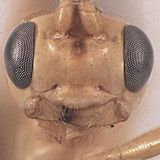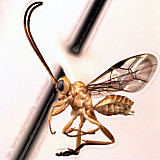Physotarsus luteus Zhaurova, 2009
Physotarsus luteus has a distinctive combination of a pale body and weakly punctate head and mesothorax. It is most similar to P. bonillai Gauld in coloration; both species are exceptionally pale with the antenna abruptly transitioning from orange proximally to dark brown apically. Physotarsus bonillai lacks the weak punctation on the head and mesoscutum, has a distinctly angulate central lobe protruding from the ventral margin of the clypeus, and has a broader petiole. The fore wing is almost completely hyaline in P. luteus.
There are no specimens currently determined for this OTU, or those specimens determined for this OTU are not yet mappable.
This material is based upon work supported by the National Science Foundation under Grant Number DEB 0328922 with REU supplement DEB 0723663.
Any opinions, findings, and conclusions or recommendations expressed in this material are those of the author(s) and do not necessarily reflect the views of the National Science Foundation.



